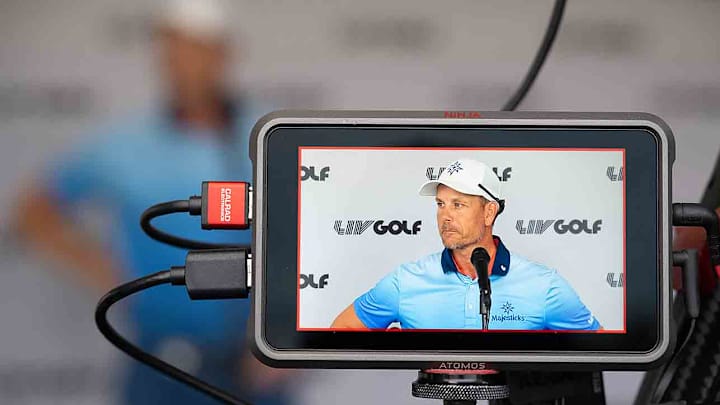Pay-Per-View Has Come to Pro Golf, Will You Pony Up?

Just when it seemed as if LIV Golf had finally run out of pranks to pull on America’s pejorative public, it hopped back into its clown suit and scared away whatever mojo it might have picked up in the first five months of 2023. Still seething after the CW Network yanked the plug on its playoff in Tulsa, which was O.K. from a geographical perspective, LIV’s caretakers immediately reunited with YouTube, which offered their tournaments free of charge to viewers in its inaugural season.
That same fluff and frivolity now comes with a $3 fee. Not that the Saudis need our loose change, but a product worth the investment would be nice. Beyond the humor and silliness of asking fans to pay for a live event airing simultaneously on cable television, the sheikhs must be much wealthier than they are patient. Their little golf enterprise needs to achieve financial solvency to survive.
They would do well not to hold their breath. At 5:50 p.m. last Saturday, a total of 29 people were connected to YouTube’s stream of the second round from northern Virginia. Twenty-nine! Given that 8 billion human beings inhabit planet Earth and more of them watch the final hour of a golf telecast than any other, a $57 haul less than a week after one of your own claimed LIV’s first major title ...

This league ain’t gonna make it, folks. No revenue + ridiculous overhead = Slim and None. The Saudis are the ones with bottomless pockets—they should be paying us to watch. You’ll be outside doing yardwork within 20 minutes, justifying the premise that pro golf doesn’t need an ounce of modernization from an outfit that can’t draw ants to a picnic.
There’s no stopping technology, however, and visual mediums are changing on the fly, always searching for ways to economize without compromise. Digital platforms are leaving cable companies in the dust. The four major networks are dumping millions on top of millions into funding their own streaming resources, a lot of it on advertising, relying on their ability as content providers to charge hefty monthly premiums for access to a massive library of movies and deceased sitcoms most of us never watch.
What does that have to do with pro golf? A whole lot. LIV surely knows it has virtually no chance of generating a profit in its partnership with YouTube, but it has nothing to lose by trying. Would you pay a weekly surcharge to watch PGA Tour events on one device or another? How much would you spend to watch the Masters? If the Royal & Ancient were to set a price of $12 for complete access to the British Open, would the USGA or PGA of America respond by assessing their market position one dollar higher?
Would you spend money on pro golf broadcasts via pay-per-view if they were the predominant way to watch the sport? 👀
— SI Golf (@SI_Golf) May 30, 2023
Comment your thoughts. ⬇️ pic.twitter.com/bmV6TEu7oN
The days of a-la-carte, pay-per-view sports aren’t that far away. When a behemoth such as ESPN can lose 914,000 customers to the cable exodus in the first quarter of 2023 alone, the men and women in the corner offices start plotting ways to save tomorrow before yesterday is finished. It’s a landslide of epic proportions, and the boulders won’t stop toppling off the mountain until supply and demand find common ground.
Many of us generally don’t ponder those nickel-and-dime, visual-entertainment expenditures in such stark terms, but the numbers obviously add up. A monthly cable/internet bill of $150 represents the low end of the standard in the northeast, where everything costs more, and you might drop another $50 on commodities such as Netflix or Paramount+. Somebody has to pay for Sylvester Stallone’s new reality show.
Disney is hemorrhaging. ESPN is bleeding at the mouth, which made the Worldwide Leader’s 2020 acquisition of exclusive PGA Tour streaming rights a roll of the dice with two fingers crossed. The nine-year deal costs ESPN $75 million annually—a colossal pile of dough for a license to follow a handful of featured groups throughout a tournament’s duration. When network coverage of the event begins Saturday afternoon, the value of that property drops substantially. Unless you’re a charter member of Jordan Spieth’s fan club, there’s not much reason to limit your viewing to a couple of notable twosomes when the entire leaderboard is the focus of the telecast on CBS or NBC.
The motivation behind ESPN’s pursuit of the Tour’s streaming contract ventures well beyond the here and now, however—any TV exec who suffers from nearsightedness can translate into a couple of hundred lost jobs. While the loss of 8 million cable subscribers (2021) reportedly cost the primary network a staggering $1 billion per year in recurring revenue, the rapid growth of ESPN+ has sparked an upbeat outlook on the future. The website/app surpassed 25 million subscribers earlier this year, bolstered by an increase of 400,000 in the first three months.
Despite a whopping increase in the monthly membership rate—my bill basically doubled at the start of 2023—ESPN still has the strength of brand recognition and personnel horsepower to take charge of the sports-app market. Pro golf represents a largely uncharted frontier; wide-open space as the legalization of gambling continues to gather momentum.
Perhaps ESPN misjudged the power of the digital invasion, thinking its cable empire could survive any form of duress. It hasn’t, not at a time when America’s viewing habits have changed so dramatically, especially among those under the age of 40. LIV Golf has a much higher opinion of itself than do the people it’s trying to reach, and it obviously doesn’t have the goods to demand a tariff from the game’s avid fanbase.
Twenty-nine viewers. Fifty-seven bucks. That probably wasn’t even enough to cover Brooks Koepka’s pre-tournament bar bill.
